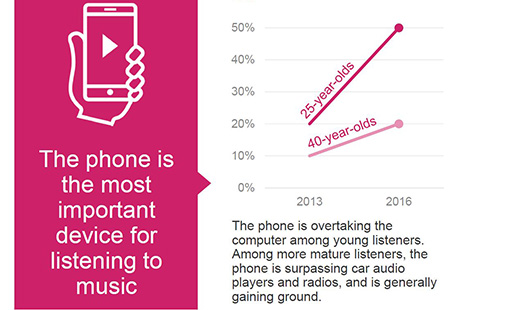Phones feeding the brisk growth of streaming services

Over just a few years, phones have become the most important music-listening device for children and young adults. YouTube is the most popular music-listening channel among people of all ages, with 32% of respondents using it every day.
The above-mentioned conclusions are based on the responses to a study conducted by Teosto and IFPI Finland in August 2016. The study looked into how digital content is consumed in Finland. The study, conducted using a Norstat research panel, gathered responses from a thousand Finns aged 16 to 65 constituting a representative population sample. Presentation material (pdf)
The use of CDs for listening to music has halved over the past three years, while the downloading that had emerged has now stopped. Of the streaming services, the one most quickly gaining in popularity in Finland is Spotify, which, according to the survey, has a total of around 1.3 million different users each week (of the free and paid versions). The paid version of Spotify is already being used by nearly 700,000 Finns.
People listen to music for an hour each day, radio and car stereos continue to be more popular
Despite the rapid changes, radio stations as a music source and car stereos as a listening device continue to be the most popular among the entire adult population: according to the study, these channels reach nearly two thirds of people aged 16 to 65 every day.
Listening to music through one’s phone on public transport, while outside or while exercising has increased swiftly. Finns typically listen to music for just over an hour per day and go to live music concerts twice a year.
Listeners are satisfied with current music services, domestic music at the top
Right now, Finns seem to be more satisfied with the possibilities for listening to music than ever before. The broadened possibilities for online listening have been praised for bringing more musical styles and new performers within the reach of listeners. Music listening is becoming more varied, and listeners feel that online services are bringing a long-awaited alternative to radio playlists. That said, several respondents commented that their tastes in music had not changed over the years. This may indicate that ageing does not necessarily affect one’s choice of music styles.
New Finnish music has become widely popular among all age groups. This can be seen in the fact that, when respondents were asked in an open question for the most popular song of the past summer, the 10 most frequently mentioned were all domestic new releases.
Finland’s use of digital services has taken great strides, Sweden still in a class of its own
The study by Teosto and IFPI used some of the same questions that were used in IFPI’s international research project conducted at the same time. The comparison of the results reveals that, over a couple of years, Finland has caught up with other countries when it comes to using phones for listening to music: Finland was previously well behind those countries favouring Android phones and iPhones.
In Sweden, Spotify’s homeland, the service is in a class of its own in terms of popularity with users: as many as 40% of all 16–65-year-old Swedes use the paid version of Spotify. The corresponding figure in Finland is 20%.
Paid TV streaming services on the rise, Yle Areena the most popular free service
Concerning the consumption of TV content, watching of recorded programmes is increasing and becoming commonplace, while at the same time, viewers are becoming more selective about the programmes they watch. A growth phenomenon of the 2010s quite similar to Spotify is the paid streaming service Netflix, which is used by nearly a million different viewers in Finland each week. In total, paid TV content is viewed via different sources (including so-called traditional pay-TV channels) by around 2 million Finns.
Of the free services, YLE Areena is by far the most popular. Two out of three survey respondents view YLE Areena as an important service for themselves, with an even distribution among all age groups.
The viewing of short video content has increased significantly in all age groups, but video bloggers and YouTubers are still mainly the domain of people under 30. However, the study reveals that a clear majority of those under 40 also watch videos online every day.
The study included a visit to a fourth-grade class at the Rastaala primary school in Espoo, during which interviews were conducted with the age group estimated to consume the most music and video online. There, a ten-year-old pupil perfectly summed up the meaning of music for all Finns who participated in the study: “Music gets rid of boring moments”.
For the study, Norstat interviewed 1,093 Finns in its consumer panel between 15 and 22 August 2016, as commissioned by IFPI and Teosto. The sample was weighted to correspond to the specific demographic of 16–65-year-old Finnish men and women. As part of the study, a qualitative group interview was also conducted with 4th graders at Rastaala primary school in Espoo, near Helsinki, and a telephone interview with six Spotify Premium users aged 50+.